
Wildlife around Ross Island (Scott Base )

Animals Verses Humans: Unless you are a scientist who has special permission to get close to animals for study reasons, humans must keep at certain distances from all the wild life. The New Zealand base and the American base have slightly different rules concerning contact. One has to stay a minimum of 5 feet away from the animal and the other is not allowed to get close enough to cause the animal any stress or abnormal discomfort. It all means the same thing: Do Not Disturb The Wildlife !! This means no pet penguins to those kids who have asked me repeatedly. No petting penguins and no feeding penguins (or any other animals); not unless you want to start feeding the
We also have to be careful about the food waste around Scott
Base. It was decided that chicken bones may be able to pass
diseases onto penguins. Totally hypothetical, but all chicken
sent down to Scott Base will be boneless from this year on.
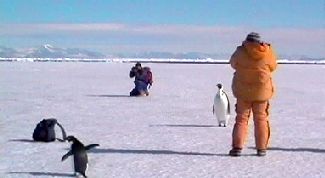
This photo was taken on one of our few trips out to the sea-ice
edge, where we are allowed to go out specifically to see the
wildlife. Notice the difference in size and stature between the
Emperor and the Adelie penguins. Also notice the distance between
people and animals.
Seals
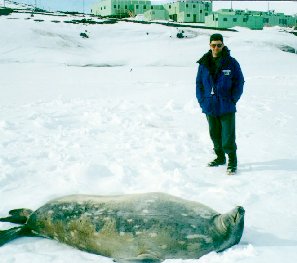 Wildlife
around Scott Base is limited to the summer only. During the
winter months (when the sea ice has frozen over in front of Scott
Base) we do not see any wildlife. As soon as the ice starts to
become thin and crack, seals come up on top of the ice and lay
around for days on end. Occasionally a penguin may turn up as
well but they try to avoid the seals. We usually only see Weddel
Seals for some reason. 'Normally' the Leopard Seals just hang
around the penguin rookeries where the eating is good. The Weddle
Seals must be after the fish.
Wildlife
around Scott Base is limited to the summer only. During the
winter months (when the sea ice has frozen over in front of Scott
Base) we do not see any wildlife. As soon as the ice starts to
become thin and crack, seals come up on top of the ice and lay
around for days on end. Occasionally a penguin may turn up as
well but they try to avoid the seals. We usually only see Weddel
Seals for some reason. 'Normally' the Leopard Seals just hang
around the penguin rookeries where the eating is good. The Weddle
Seals must be after the fish.
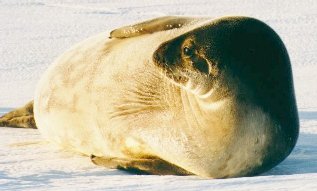 I think the males
are the first to arrive and then the females arrive to have their
pups, and then get ready to copulate again. Male seals have this
bad habit of trying to bite off other males genitalia when having
a fight. Even the females will do it to weak males who try to
copulate with them while they are resting on the surface of the
ice. The weaker males are always trying to get some action while
the big males are away protecting their territories under the ice.
I think the males
are the first to arrive and then the females arrive to have their
pups, and then get ready to copulate again. Male seals have this
bad habit of trying to bite off other males genitalia when having
a fight. Even the females will do it to weak males who try to
copulate with them while they are resting on the surface of the
ice. The weaker males are always trying to get some action while
the big males are away protecting their territories under the ice.
Weddle Seals are a very passive animal compared to the Leopard Seals. The scientists who work with the animals during their studies say that the Weddle Seals snap at them alot if they get too close but they hardly ever actually bite or attack. The Leopard Seals, on the other hand, are vicious animals that can't be trusted. Mike ( our engineer ) said they are easy to recognize because they have a head shaped like a prehistoric T-REX; big jaws and very nasty teeth.


Penguins
We normally only see Adelie Penguins as the big rookeries around the north end of the island are mostly Adelie's. Adelies are a humorous sort of an animal with a laughable personality. Always striding along as if they are in a hurry to get somewhere. They never get too close as they seem uncertain of human contact. They walk like small Charlie Chaplains and are very inquisitive, only getting close enough to see what they want and are off again.

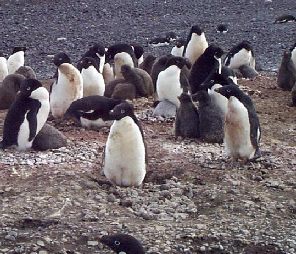

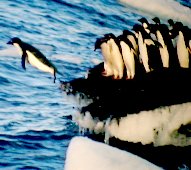
In the photos above you see both an Addelie penguin colony and a penguin being pushed in. Penguins normally line up around the waters edge and then wait around not certain if the water is safe to dive into. This causes a bit of impatience and the closest one to the edge is normally pushed in. As my editor would say, "The sacrificial penguin!!". Once the first one is in its all on and they cant get into the water fast enough.
There are times, however, when we see Emperor Penguins strolling around. Emperors are very large and inquisitive animals; very regal in nature and behavior. They will often come right up and inspect you personally. By standing quietly, it is not uncommon for several of them to surround you and stand looking in your direction.
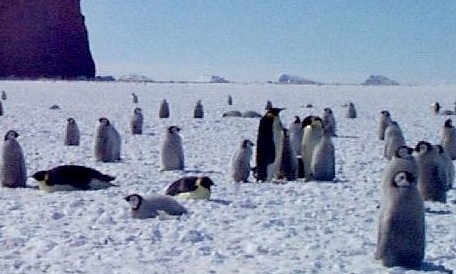
This looks like an Emperor Penguin rookery; don't know where, don't know when. But I do know it's somewhere around Antarctica .
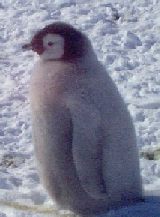
A picture of a cute, little Emperor Penguin chick. The term fuzz ball comes to mind but at least he is warm under there.
Ever had one of those headless penguin sort of days. The Emperor Penguin has got a very long neck and can stretch it so far it looks unnatural or pull it right down into itself so that it looks like it has no neck at all.

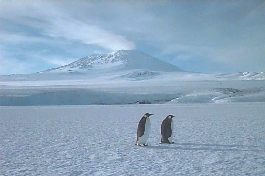
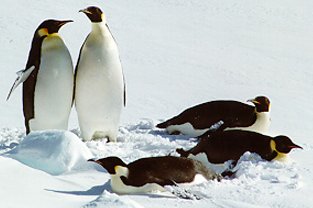
Emperor Penguins are great travelers and have been known to walk to some very unusual places. Maybe they enjoy the scenery as much as we do, often traveling in pairs or groups. They normally mate for life, but scientist have found out that Emperors are often unfaithful to their partners and have the odd fling on the side. I suppose variety is the spice of life. In this photo Eribus (situated on Ross Island) is seen in the background and is venting large amounts of steam, as it often does.
Skewers
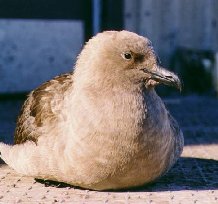
The Skewer is like a seagull of the Antarctic. It looks just like a large brown motley colored seagull and it often raids the food scraps from around Mactown and Scott Base. They also terrorize the penguin colonies on the lookout for stray chicks or eggs to eat, and they will often attack and kill a lone penguin. They sometimes make nests around Scott Base shore-front which we have to avoid when shifting snow, etc.
Killer Whales (Orcas)
 The Leopard Seals seem to be intent on
eating the Adelie Penguins and maybe a few Emperor Penguins but
that is not the only predator in the Antarctic waters. The Killer
Whales have a fetish for the large Emperor Penguins and seals.
Orcas have a bad habit of sometimes playing with their food for
long periods of time before killing and eating it. The scientist
this year measured the speed at which Emperor Penguins could exit
the water. I'm sure they said it could be as quick as 70 km per
hour. Mind you, if I had a Killer Whale look at me for its next
feed, I think I would learn to get out of the water pretty quick
as well.
The Leopard Seals seem to be intent on
eating the Adelie Penguins and maybe a few Emperor Penguins but
that is not the only predator in the Antarctic waters. The Killer
Whales have a fetish for the large Emperor Penguins and seals.
Orcas have a bad habit of sometimes playing with their food for
long periods of time before killing and eating it. The scientist
this year measured the speed at which Emperor Penguins could exit
the water. I'm sure they said it could be as quick as 70 km per
hour. Mind you, if I had a Killer Whale look at me for its next
feed, I think I would learn to get out of the water pretty quick
as well.
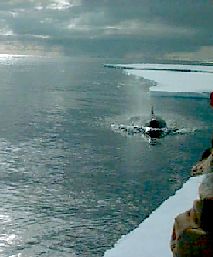 In this photo (which
is typical of many of our experiences) we stand reasonably close
to the ice edge (which is about a meter thick) and we watch the
Orcas chasing the penguins. Though I don't know where this photo
was taken, it is an experience which some of us will never forget.
In this photo (which
is typical of many of our experiences) we stand reasonably close
to the ice edge (which is about a meter thick) and we watch the
Orcas chasing the penguins. Though I don't know where this photo
was taken, it is an experience which some of us will never forget.
The Orcas (Killer Whales) are often seen in front of Scott Base when the water is free of ice. They come in to hunt seals and normally the Killer Whale will hunt in groups (or pods). The whole family participates in food gathering so unless you can get out of the water fast when a Killer Whale is present, you don't have much chance for escape.
A few stories people may not have heard about Killer Whales:
Killer Whales are very intelligent mammals and have devised some
extraordinary techniques for hunting. They are well known for
getting together and tipping up small icebergs so that any
sleeping seals slide helplessly into the mouths of the waiting
Killer Whales. Or they will break through thin ice (up to about
half a meter or more) to capture their prey.
A crew from Green Peace had first hand experience when they where
watching a pod of Killer Whales playing at the front of their
boat. What they didn't know was that several of the larger Killer
Whales (not in the process of distracting the small ship's crew)
had gone behind the boat. It didn't take the crew long to get a
bit scared when the large male killer whales behind the boat
tried to lift it out of the water, the same as they do to small
ice bergs to get the seals off the ice. The crew promptly left
the area a bit shaken.
They have also been know to follow cross country skiers under the thin ice and blow bubbles under their feet to make the ice tremble. To them its just a game because if they can do that it is no trouble at all to break through the ice, which they often do, just to prove the point.
The green peace guys have also seen them working in a team to get the most difficulty located food. They actually saw an Orca beach itself totally on an iceberg to get close enough to grab a seal and then two of its mates half beached themselves on the same iceberg behind it, grabbed a half tail fin each in their mouths and then dragged their mate back into the water with them.
Its scary to think how organized and self controlled these animals are.
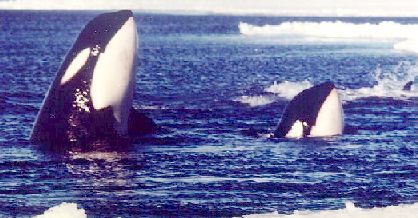
These Killer Whales are spy hopping. They stick their heads out of the water to get some height and then look around. I presume they do this to look for the next meal.
Orcas have also been know to sneak up behind unwary divers and nibble on the divers flippers as a kind of underwater joke. Personally it wouldn't matter how deep I was, to hell with decompression stops. I'm outa there. So you may trust Orcas as much as you like, and think they are really great animals, but after hearing those stories, personally I prefer to see them from safe distance and on land.
Minky Whales
Minky Whales are also seen cruising around the Scott
Base waters when there is enough clear (ice-free) water. They
were the first of the whales to arrive at the melt pools and came
in as soon as the icebreakers cleared the main channels into
McMurdo Station.
Other Fish
The scientists study a large variety of fish; everything from the big Antarctic Cod, to the little fish you see below. They study them for different reasons: the amount of toxins in their bodies, antifreeze capabilities of their blood, inherent diseases within certain species and how it effects other fish, etc. At the beginning of the summer season large holes are cut in the ice and small huts (with oil heaters) are set over top of them. This allows the scientists to reel in the fish while in some comfort. If the sea floor is not too far down then they may also use baskets to catch small fish and other creatures.

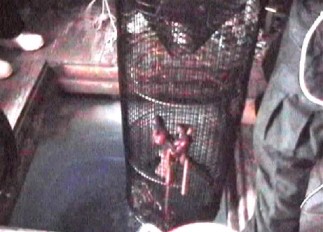
The fish basket above contains sea slugs, sea roaches and a few other really ugly critters from the sea floor in Winter Quarters Bay... gross enough to make your tummy turn.
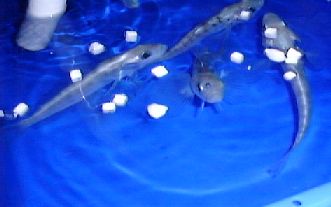
These fish have no red blood cells and scientists are curious
as to how the oxygen gets around their body without the red blood
cells as the normal means of transport. These particular fish are
in the wet lab at Scott Base being studied. I think they also
have a disease which is prevalent in the species and they are
trying to find out the mortality rate and how the disease spreads
from fish to fish.

Antarctic Cod: a very deep-water fish that grows up to 6 feet in length. They hardly even struggle when the scientist hook them on the line and they don't seem to be affected by the bends or anything when retrieved out of deep water. Like most Antarctic fish they don't move around much because of reduced oxygen at the depth they are caught and the low amount of red blood cells they have in their bodies. Red blood cells will freeze so most fish have as few as possible to survive. They also have an antifreeze like substance in their blood which stops them from turning into blocks of ice with the constant cold temperatures.

You are not allowed to go fishing unless you are
a scientist and it is for research. When the scientists are
finished with things like the big Cod, they often end up on the
menu at the mess at Scott Base or the galley at Mactown. They don't
taste bad either.
www.geocities.com/coolrunnernz/
9-3-01
Writen by Ray Young
Edited by Shirley Baston Fred [email protected] ICQ # 15167279